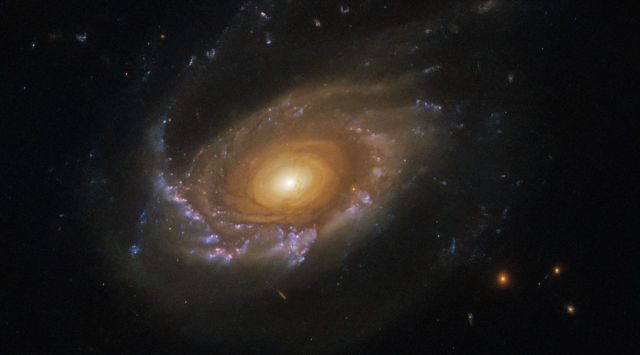NASA/ESA හබල් අභ්යවකාශ දුරේක්ෂය මගින් කෝමා බෙරෙනිසස් තාරකා මණ්ඩලයේ ආලෝක වර්ෂ මිලියන 900ක් ඈතින් පිහිටි ජෙලිෆිෂ් මන්දාකිණියක් වන JW39 හි විශ්මයජනක රූපයක් එළිදක්වා ඇත. එහි සන්සුන් පෙනුම තිබියදීත්, මෙම මන්දාකිණි ආශ්චර්යය පවතින්නේ මන්දාකිණි පොකුරේ කටුක සහ සමාව නොදෙන භූමි ප්රදේශයක ය.
මන්දාකිණි පොකුරු, මන්දාකිණි සිය ගණනක් හෝ දහස් ගණනකින් සමන්විත දැවැන්ත ව්යුහයන්, ගුරුත්වාකර්ෂණ බලයේ අප්රතිහත ග්රහණයෙන් එකට බැඳී ඇති විශ්වයේ සැබෑ ටයිටන් වේ. මෙම පොකුරු තුළ, මන්දාකිණි බොහෝ විට ඔවුන්ගේ වඩා සැලකිය යුතු අසල්වැසියන්ගේ ගුරුත්වාකර්ෂණ බලපෑමෙන් විකෘති වී ඒවා විවිධ හැඩතලවලට විකෘති කරයි. කොස්මික් නාට්යයට එකතු කරමින්, පොකුරු තුළ මෙම මන්දාකිණි වෙන් කරන අවකාශය අන්තර් ක්ලස්ටර් මාධ්යය ලෙස හැඳින්වෙන සිහින් සහ උණුසුම් ප්ලාස්මාවකින් විනිවිද යයි.
JW39, එය පොකුර හරහා ගමන් කරන විට, අන්තර් ක්ලස්ටර් මාධ්ය මගින් ඇති කරන දැවැන්ත පීඩනය විඳදරා ගනී. එහි ප්රතිඵලයක් වශයෙන්, මෙම සතුරු පරිසරය එහි වායුව සහ දූවිලි ඉවත් කර, ජෙලිෆිෂ්ගේ කූඩාරම්වලට සමාන තාරකා සෑදීමේ දිගු රිබන් බවට මූර්තිමත් කරයි. "ram-pressure stripping" ලෙසින් හඳුන්වන මෙම සංසිද්ධිය මන්දාකිණියට එහි ආකර්ශනීය ජෙලිෆිෂ් වැනි පෙනුමක් ලබා දෙයි. ආලෝක වර්ෂ දස දහස් ගණනක් පුරා විහිදෙන මෙම දිගටි උපග්රන්ථ, මන්දාකිනියෙන් බලහත්කාරයෙන් මිරිකන ලද වායු සහ දූවිලි වල ශේෂයන් මූර්තිමත් කරයි.
තාරකා විද්යාඥයින්, හබල්ගේ අති නවීන Wide Field Camera 3 භාවිතා කරමින්, තරු සෑදීම සඳහා ඔවුන් ඉදිරිපත් කරන අසාමාන්ය ආන්තික තත්වයන්ට වශී වී, මෙම කූඩාරම් ඉතා වෙහෙස මහන්සි වී පරීක්ෂා කර ඇත. පුදුමයට කරුණක් නම්, ඔවුන්ගේ නිරීක්ෂණවලින් හෙළි වී ඇත්තේ ජෙලිෆිෂ් මන්දාකිණිවල කූඩාරම් තුළ ඇති වන තරු සෑදීම මන්දාකිණි තැටිය තුළට සම්ප්රේෂණය වන ආකාරයට කැපී පෙනෙන සමානකමක් ඇති බවයි. මෙයින් ඇඟවෙන්නේ කූඩාරම් තුළ ඇති තරු ආරම්භ වන්නේ මන්දාකිණියේ පෙර පරම්පරාවල තරු මගින් බර මූලද්රව්ය වලින් පොහොසත් වූ වායුවෙනි.
පසුගිය වසර දෙක තුළ, හබල් විසින් JW39 වෙනත් ජෙලිෆිෂ් මන්දාකිණි කිහිපයක් සමඟ සමීපව පරීක්ෂා කර ඇති අතර, GASP (MUSE සමඟ මන්දාකිණිවල GAs Stripping Phenomena) ලෙස නම් කරන ලද ව්යාපෘතියකට මූලිකත්වය ගෙන ඇත. මෙම මුලපිරීමේ මූලික පරමාර්ථය වන්නේ මන්දාකිණිවල පරිණාමය සහ ඒවායේ තරු සෑදීමේ ක්රියාකාරකම් මත රැම්-පීඩනය ඉවත් කිරීමේ බලපෑම අවබෝධ කර ගැනීමයි. මෙම ජෙලිෆිෂ් මන්දාකිණි, අසාමාන්ය සහ තාවකාලික ස්වභාවයක් පෙන්නුම් කරයි, මන්දාකිණි මන්දාකිණි පොකුරු තුළ ඝන ලෙස ඇසුරුම් කළ ප්රදේශ හරහා ගමන් කරන විට පමණි. ඔවුන්ගේ ලක්ෂණ ගවේෂණය කිරීම, මන්දාකිණි සහ ඒවායේ වටපිටාව අතර ඇති සංකීර්ණ නර්තනය පිළිබඳ අගනා අවබෝධයක් ලබා දීම, ඔවුන්ගේ පරිවර්තනීය ගමන මෙහෙයවන යාන්ත්රණයන් කෙරෙහි ආලෝකය විහිදුවයි.
Hubble's Wide Field Camera 3 සමඟින් ලබාගත් JW39 හි මෙම විශේෂිත රූපය, මන්දාකිනියේ පුළුල් පසුපස කූඩාරම් තරු සෑදීමෙන් පිරී ඇති අතර, එහි මධ්යම තැටිය සමඟ පෙර නොවූ විරූ ලෙස විස්තරාත්මකව පෙන්වයි. තවද, රූපය කොමා බෙරෙනිසස් තාරකා මණ්ඩලය තුළ මන්දාකිණිය ස්ථානගත කරමින් ආකාශ සිතියමක් සපයයි.
JW39 සහ එහි ජෙලිෆිෂ් සහචරයින් ඔවුන්ගේ විශ්වීය වටපිටාව තුළ මන්දාකිණිවල පරිණාමය සහ අන්තර් ක්රියාකාරිත්වය අවබෝධ කර ගැනීමේ වැදගත් ඉදිරි පිම්මක් පෙන්නුම් කරයි. මෙම අද්විතීය ජෙලිෆිෂ් මන්දාකිණි පිළිබඳ අධ්යයනය එකවරම තරු සෑදීම සහ අපගේ පරිණාමය වන විශ්වයේ ආකර්ශනීය කතාව පිළිබඳ ගැඹුරු හෙළිදරව් කිරීම් ඉදිරිපත් කරයි.
In a remarkable display of celestial beauty, the NASA/ESA Hubble Space Telescope has unveiled a breathtaking image of JW39, a jellyfish galaxy situated a staggering 900 million light-years away in the Coma Berenices constellation. Despite its serene appearance, this galactic marvel resides in the harsh and unforgiving territory of a galaxy cluster.
Galaxy clusters, colossal structures comprising hundreds or thousands of galaxies, are the veritable titans of the cosmos, bound together by the irresistible grip of gravity. Within these clusters, galaxies often suffer distortion from the gravitational influence of their more substantial neighbors, contorting them into a diverse array of shapes. Adding to the cosmic drama, the space separating these galaxies within clusters is permeated by a tenuous and searing-hot plasma called the intracluster medium.
JW39, as it traverses the cluster, endures the immense pressure exerted by the intracluster medium. Consequently, this hostile environment strips away its gas and dust, sculpting them into extended ribbons of star formation, akin to the tentacles of a jellyfish. Termed "ram-pressure stripping," this phenomenon bestows the galaxy with its captivating jellyfish-like appearance. These elongated appendages, spanning tens of thousands of light-years, embody the remnants of gas and dust that were forcibly wrenched from the galaxy.
Astronomers, utilizing Hubble's state-of-the-art Wide Field Camera 3, have painstakingly examined these tentacles, fascinated by the extraordinarily extreme conditions they present for star formation. Astonishingly, their observations have revealed that the star formation occurring within the tentacles of jellyfish galaxies bears striking similarity to that transpiring within the galactic disk. This suggests that the stars within the tentacles originate from gas previously enriched with heavy elements by preceding generations of stars in the galaxy.
Over the past two years, Hubble has closely scrutinized JW39 alongside several other jellyfish galaxies, spearheading a project christened GASP (GAs Stripping Phenomena in galaxies with MUSE). The primary objective of this initiative is to fathom the impact of ram-pressure stripping on the evolution of galaxies and their star-forming activities. These jellyfish galaxies, extraordinary and ephemeral in nature, only manifest when galaxies traverse densely packed regions within galaxy clusters. Exploring their characteristics stands to furnish invaluable insights into the intricate dance between galaxies and their surroundings, shedding light on the mechanisms driving their transformative journey.
This particular image of JW39, acquired with Hubble's Wide Field Camera 3, showcases the galaxy's extensive trailing tentacles brimming with star formation, alongside its central disk, in unprecedented detail. Furthermore, the image provides a celestial map, locating the galaxy within the Coma Berenices constellation.
JW39 and its jellyfish companions herald a momentous leap forward in comprehending the evolution and interplay of galaxies within their cosmic environs. The study of these unique jellyfish galaxies simultaneously offers profound revelations about star formation and the captivating tale of our evolving universe.





